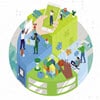Link opens in a new tab
opens in new window


Smart City Environment and Energy
Uncover the environmental impacts of smart city technology
For a smart city to live up to its name, using technology to foster sustainable growth is essential. Cities must push toward a wiser use of resources, from implementing sensors that detect leakage to using behavioral economics and gamification to encourage citizens to make thoughtful decisions on resource use.
Smart city environment and energy trends
Explore the smart cities of the future
Case studies
Take a closer look at how cities, agencies, and companies around the world are implementing these smart city environment, energy, and sustainability strategies.


Opens in new window
Smart cities of the future: From vision to reality
Explore our full collection of smart cities insights
